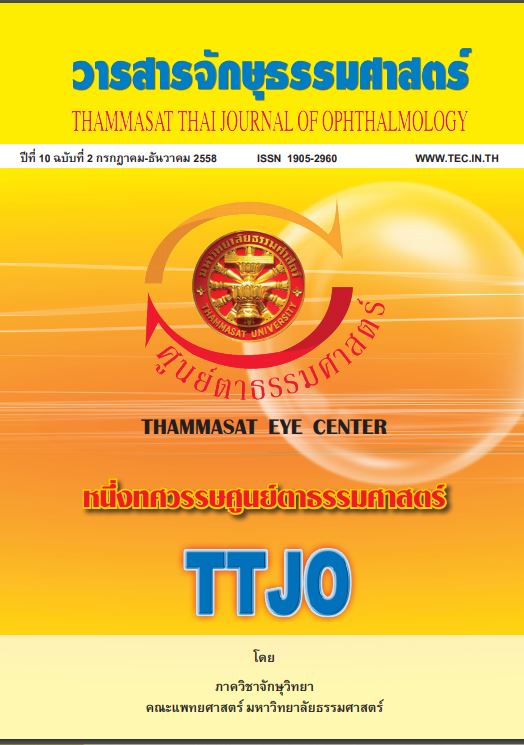การเปรียบเทียบผลการตรวจผ่านกล้องด้วยวิธีใช้เลนส์สัมผัสและวิธีใช้เลนส์ไม่สัมผัสโดยแพทย์ประจำบ้านจักษุวิทยาในการตรวจหาภาวะจุดรับภาพบวมจากโรคเบาหวาน
Main Article Content
Abstract
บทคัดย่อ
จุดประสงค์ : เพื่อเปรียบเทียบผลของการตรวจผ่านกล้องด้วยวิธีใช้เลนส์แบบสัมผัสและวิธีแบบใช้เลนส์ไม่สัมผัสโดยแพทย์ประจำบ้านสาขาจักษุวิทยา ในการตรวจหาภาวะจุดรับภาพบวมจากโรคเบาหวาน
วิธีการศึกษา : ศึกษาในผู้ป่วยเบาหวานขึ้นจอประสาทตาทุกระดับความรุนแรง ในหน่วยตรวจตา โรงพยาบาลธรรมศาสตร์เฉลิมพระเกียรติ โดยผู้ป่วยจะได้รับการตรวจจุดรับภาพผ่านกล้องด้วยวิธีใช้เลนส์ไม่สัมผัสและวิธีใช้เลนส์สัมผัสจากแพทย์ประจำบ้านชั้นปีที่2หรือปีที่3 ของภาควิชาจักษุวิทยา คณะแพทยศาสตร์ มหาวิทยาลัยธรรมศาสตร์ หลังจากนั้นผู้ป่วยจะได้รับการตรวจซ้ำโดยอาจารย์แพทย์ด้วยวิธีใช้เลนส์ไม่สัมผัส และวิธีใช้เลนส์สัมผัสอีกครั้ง แล้วนำผลการตรวจวิธีต่างๆของแพทย์ประจำบ้านมาคำนวณหาค่าความไว ความจำเพาะ และ พื้นที่ใต้กราฟ Reciever Operating Characteristic (AuROC) โดยใช้ผลการตรวจด้วยวิธีใช้เลนส์สัมผัสจากอาจารย์แพทย์เป็นเกณฑ์มาตรฐาน
ผลการศึกษา : จำนวนตา 40ตา จากผู้ป่วย 20 คน อายุระหว่าง38ถึง71ปี เข้าเกณฑ์ในการศึกษาครั้งนี้ ตรวจพบภาวะจุดรับภาพบวมจากโรคเบาหวานจำนวน21ตา คิดเป็น 52.5 %โดยแพทย์ประจำบ้านปีที่2และ3 ทำการตรวจตาจำนวน24ตาและ16ตาตามลำดับ ซึ่งพบว่าค่าความไว, ความจำเพาะ, AuROC ของการตรวจด้วยวิธีใช้เลนส์ไม่สัมผัสโดยแพทย์ประจำบ้านปีที่2และปีที่3 เป็น50%,80%,65%และ100%,77.8%,89% ตามลำดับ ส่วนค่าความไว, ความจำเพาะ, AuROC ของการตรวจด้วยวิธีใช้เลนส์สัมผัสโดยแพทย์ประจำบ้านปีที่2และปีที่3 เป็น71.7%,70%,71%และ100%,88.9%,94%ตามลำดับ
ผลสรุป : ในการตรวจหาภาวะจุดรับภาพบวมจากเบาหวานโดยการตรวจผ่านกล้อง แพทย์ประจำบ้านปีที่3 มีความแม่นยำในการตรวจหาด้วยวิธีใช้เลนส์แบบสัมผัสอยู่ในเกณฑ์ดีมากและวิธีใช้เลนส์แบบไม่สัมผัสอยู่ในเกณฑ์ดี ดังนั้นจึงสามารถใช้วิธีแบบเลนส์ไม่สัมผัสในการตรวจได้เพื่อความสะดวกรวดเร็วในการตรวจหรือ หลีกเลี่ยงข้อเสียจากการใช้เลนส์สัมผัส แต่ในกรณีที่ต้องการความแม่นยำมากขึ้น หรือ ผู้ป่วยที่ไม่ร่วมมือควรใช้วิธีแบบเลนส์สัมผัส ในขณะที่แพทย์ประจำบ้านปีที่2 ที่มีแม่นยำจากการตรวจทั้ง2วิธีอยู่ในเกณฑ์พอใช้จึงควรต้องมีการฝึกฝนในการตรวจโดยวิธีใช้เลนส์สัมผัสที่เป็นวิธีมาตรฐานให้มีความชำนาญเสียก่อนจึงค่อยฝึกฝนวิธีใช้เลนส์ไม่สัมผัสต่อไป
Comparison of contact lens versus non-contact lens biomicroscopy by ophthalomology residents for the detection of diabetic macular edema
Abstract
Objective: To compare the detecting result of diabetic macular edema between the contact lens biomicroscopic method and the non-contact lens biomicroscopic method by the ophthalmology residents.
Methods: Study participants consisted of all patients with any stage of diabetic retinopathy in the eye clinic of Thammasat hospital. Case characteristics were recorded and eyes were examined by the 2nd or 3rd year ophthalmology residents by means of non-contact lens and contact lens biomicroscopy, respectively. All participants were also re-examined by retinal specialist by both methods to ensure the diagnostic result. The findings by both methods from the residents were compared to the contact lens method from the retinal specialist and then were analyzed with the sensitivity, specificity and Area under Receiver Operating Characteristic (AuROC).
Results: Forty eyes of 20 patients in the age of 31-78 years old were enrolled in this study. Twenty one eyes of 40 eyes (52.5%) have diabetic macular edema. Twenty four eyes of 40 eyes and 16 eyes of 40 eyes were examined by the 2nd and 3rd year ophthalmology residents respectively. The sensitivity, specificity and AuROC by the non-contact biomicroscopic method from the 2nd and 3rd year residents were 50%,80%,65% and 100%,77.8%,89% respectively; meanwhile, the sensitivity, specificity and AuROC by the contact biomicroscopic method from the 2nd and 3rd year residents were 71.7%,70%,71% and 100%,88.9%,94% respectively.
Conclusion: For detection of diabetic macular edema with the microscopy by the 3rd year residents, the accuracy of the contact lens method is quite outstanding and for the non-contact lens method is good. As a result, if the rapid examination is required or to avoid the disadvantages of the contact lens method, the non-contact lens method would be a useful choice. Meanwhile, in case of the more accuracy or in the uncooperative patients, the contact lens method should be use for detection. However, for the 2nd year residents, the accuracy from the both methods are poor; therefore they should firstly practice detecting by the contact lens which is the present standard method and learn more experience to do the non-contact lens method later.
Article Details
References
Bhagat N, Grigorian RA, Tutela A, Zarbin MA. Diabetic macular edema: pathogenesis and treatment.Surv Ophthalmol. 2009 Jan-Feb;54(1):1-32. doi: 10.1016/j.survophthal.2008. 10.001.
Pelzek C, Lim JI. Diabetic macular edema: review and update.Ophthalmol Clin
North Am. 2002 Dec;15(4):555-63.
Singh R, Ramasamy K, Abraham C, Gupta V, Gupta A. Diabetic retinopathy: an update.Indian J Ophthalmol. 2008 May-Jun;56(3):178-88
Bandello F, Pognuz R, Polito A, Pirracchio A, Menchini F, Ambesi M. Diabetic macular edema: classification, medical and laser therapy. Semin Ophthalmol. 2003 Dec;18(4):251-8.
Paris G. Tranos, FRCS(G),Sanjeewa S.Wickremasinghe. Macular edema. Surv Ophthalmol. 2009 Jan-Sep;49(5):470-490
Yang XL, Liu K, Xu X. Update on treatments of diabetic macular edema.Chin Med J (Engl). 2009 Nov 20;122(22):2784-90.
สำนักนโยบายและยุทธศาสตร์ สำนักงานปลัดกระทรวงสาธารณสุข. รายงาน NCD ๑ ปีงบประมาณ ๒๕๕๔ ( ตามแบบรายงาน NCD ๑ งวดที่ ๑-๒) ในโครงการสนองน้ำพระราชหฤทัย ในหลวงทรงห่วงใยสุขภาพประชาชน
Klein R, Klein BEK, Moss SE, Cruckshanks KJ. The Wisconsin epidemiology study of diabetic retinopathy. XV. The long term incidence of macular edema. Ophthalmology. 1995; 102:7-16
Bru SC,Bressler SB,Maguire MG.A comparision of fundus biomicroscropy and 90 diopter lens examination in the detection of diabetic clinically significant macular edema.Invest Ophthalmol Vis Sci.1993;34:718
Early Treatment Diabetic Retinopathy Study Research Groups. Focal photocoagulation treatment of diabetic macular edema. Relationship of treatment effect to fluorescein angiographic and other retinal characteristics at baseline: ETDRS report no. 19. Arch Ophthalmol. 1995 Sep;113(9):1144-55


